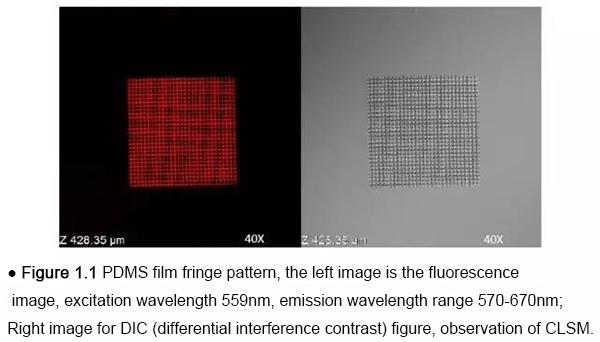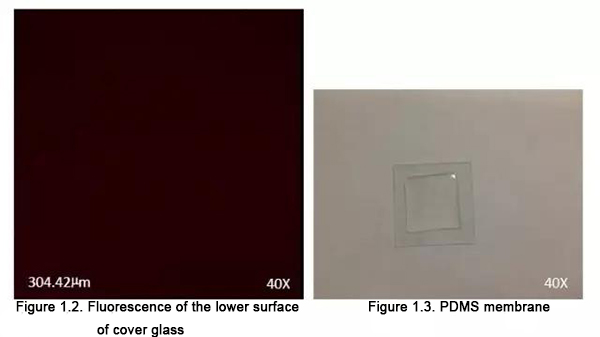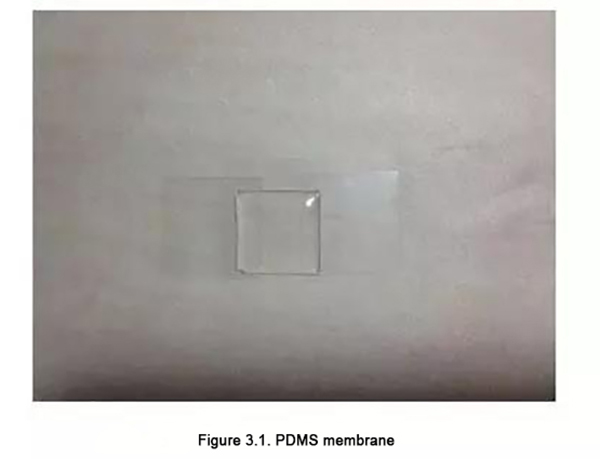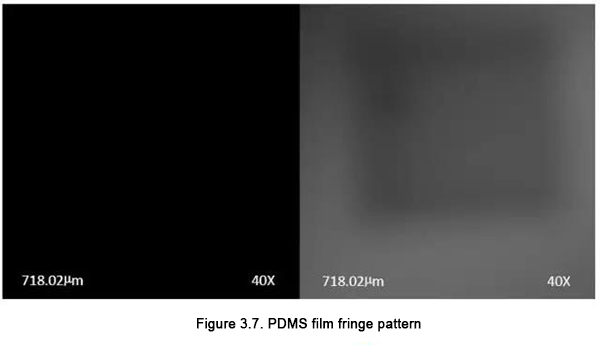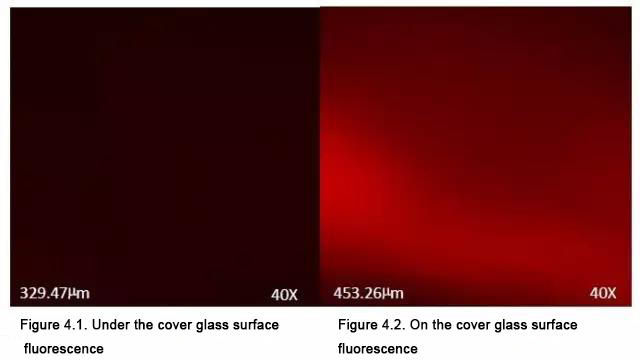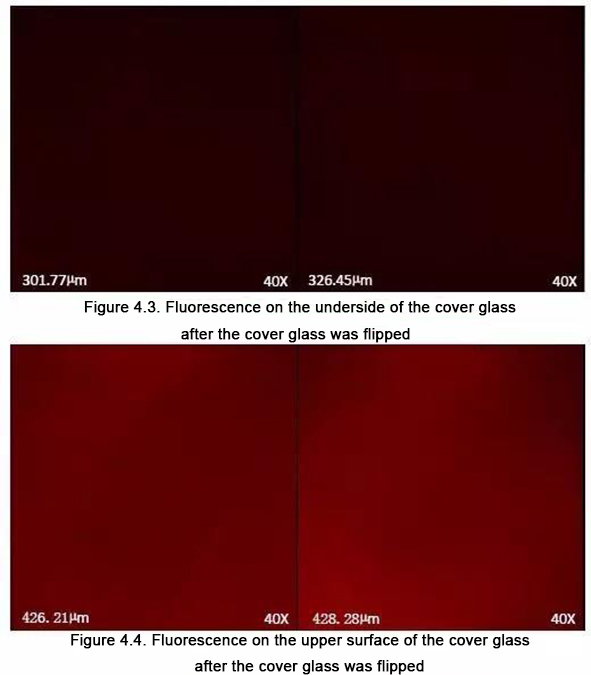In the confocal laser experiment, a very thin cover glass is needed to carry the sample, the thickness of which is about 120μm to 170μm. The closeness between the sample and the cover glass will directly affect the fluorescence observation of the sample, and sometimes it will produce false appearance.
For cell samples, in general, cells are cultured in Confocal dishes, and cells grow on the cover glass at the bottom of Confocal dishes by sticking on the wall. The cells are closely fitted to the cover glass, and the observed cell fluorescence is the true situation of the samples. Some solid particles, powder or liquid samples, such as close to the cover glass, observed sample fluorescence is true fluorescence; However, for some film samples, such as thick sample with uneven surface, and cover glass can not be closely fitted, it will be unable to focus the sample or produce fluorescence illusion. Taking a PDMS film as an example, there are some fringe patterns on this film, which contain fluorescent quantum dots. The purpose is to observe whether the quantum dots are wrapped in the fringe patterns on the PDMS film. The adherence of PDMS film to cover glass will affect the observation of quantum dot fluorescence in fringe pattern.
1.PDMS film and cover glass are closely attached
Note: Confocal focus was Olympus FV1000-IX81 and inverted fluorescence microscope was used. The number in the lower left corner of the picture reflects the relative distance between the objective lens and the sample. The larger the value is, the closer the lens moves up and the closer the distance is to the cover glass. The lower right corner shows the magnification of the objective lens used. For all confocal images in this communication, the acquisition parameters of fluorescence images were identical under the 40X objective lens.
At the PDMS film cover, the PDMS film is in close contact with the upper surface of the cover glass, in the same focal plane. Quantum dots in the stripe pattern on the PDMS film fluoresse, as shown in FIG. 1.1. Fluorescence was visible on the lower surface of the cover glass, as shown in Figure 1.2. The upper surface of the cover glass was in close contact with the PDMS film, and the fluorescence on the upper surface of the cover glass was not observed.
2. There is a gap between the PDMS film and the cover glass, and the lower surface of the film does not closely fit the cover glass
When there is a gap between the PDMS film and the cover glass and the adhesion degree is not good, the lower surface of the PDMS film and the upper surface of the cover glass are not in the same focal plane, and the fluorescence of the quantum dots at the fringe is very weak, as shown in Figure 2.1. The reason may be that after the laser penetrates the cover glass, it reflects and refracts on the upper and lower surfaces of PDMS film, so that the laser passing through the upper and lower surfaces of PDMS film will have the destructive interference, and the laser cannot enter the fringe, so there is no fluorescence at the fringe. Whether the laser cancelling interference occurs depends on the thickness of PDMS film, the gap between the film and the cover glass and the laser wavelength.
It was also found that there was fluorescence outside the PDMS film fringes, which should be an illusion, because in the first case, the film was closely fitted to the cover glass and there was no fluorescence outside the PDMS film fringes, as shown in FIG. 1.1. It is suspected that it is the fluorescence illusion of the upper surface of the cover glass after the reflection of the fluorescence on the lower surface of the film. The fluorescence of the upper and lower surfaces of the cover glass can be observed from FIG. 2.2 and 2.3, and the thickness of the cover glass is about 120 microns. The upper surface of the cover glass is about 60 microns away from the PDMS film.
3. A cover glass is sandwiched between PDMS film and cover glass to enlarge the gap
When a cover glass is sandwiched between the PDMS film and the cover glass, the fluorescence on the upper and lower surfaces of the cover glass can be observed under 20X and 40X objective lenses when the gap increases. In the same way as in the second case, the fluorescence of the quantum dots at the PDMS film fringe is very weak, as shown in FIG. 3.4. As the distance between PDMS film and objective lens increases, the 40X objective lens has a small depth of field and cannot focus, so the stripes on PDMS film cannot be clearly seen, as shown in FIG. 3.7.
4. Fluorescence on the upper and lower surfaces of cover glass
During the experiment, it was always found that the fluorescence of the upper surface of the cover glass was stronger than that of the lower surface. In fact, the fluorescence of the upper surface was not stronger than that of the lower surface. However, the objective lens of the instrument is calibrated with 0.17mm thick cover glass. When the sample is closely attached to the upper surface of 0.17mm thick cover glass, the laser is focused on the sample surface after passing the lens, and the fluorescence is strongest at this time. The fluorescence of the lower surface of the cover glass is weak because the laser is not focused on this surface.
As can be seen from FIG. 4.1-4.4 above, after the upper and lower surfaces of the cover glass are flipped, the fluorescence on the lower surface of the cover glass is still weak, while the fluorescence on the upper surface is strong, which verifies that this phenomenon is indeed caused by laser focusing. It can be seen from Figure 4.3 that the focal plane of the cover glass varies slightly with the position of the cover glass, which is caused by the uneven surface of the cover glass.
In a word, the clinginess between the sample and the cover glass will seriously affect the fluorescence morphology of the sample, sometimes unable to focus, sometimes produce fluorescence illusion. Therefore, when preparing membrane samples, it is necessary to ensure that the sample surface is as flat and thin as possible. Before confocal observation, the sample can be flattened in advance. Smaller sample area is easier to flatten. The cover glass had better be soaked with concentrated sulfuric acid before use to remove the surface grease, but the fluorescence phenomenon still exists.
Post time:2024-08-01

